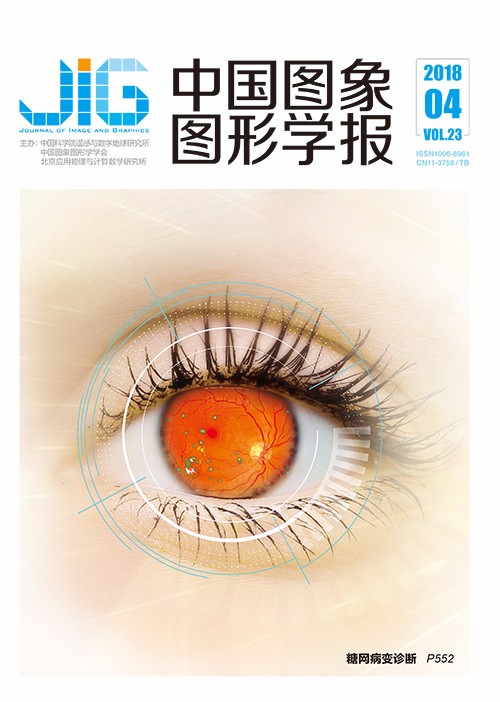
融合双特征图信息的图像显著性检测方法
摘 要
目的 图像的显著性检测是将图像中最重要的、包含丰富信息的区域标记出来,并应用到图像分割、图像压缩、图像检索、目标识别等重要领域。针对现有研究方法显著性目标检测结果不完整以及单一依靠颜色差异检测方法的局限性,提出一种综合图像底层颜色对比特征图和图像颜色空间分布特征图的显著性检测方法,能够有效而完整地检测出图像中的显著性区域。方法 本文方法结合了SLIC超像素分割和K-means聚类算法进行图像特征的提取。首先,对图像进行SLIC(simple linear iterative clustering)分割,根据像素块之间的颜色差异求取颜色对比特征图;其次,按照颜色特征对图像进行K-means聚类,依据空间分布紧凑性和颜色分布统一性计算每个类的初步颜色空间分布特征。由于聚类结果中不包含空间信息,本文将聚类后的结果映射到超像素分割的像素块上,进一步优化颜色空间分布图;最后,通过融合颜色对比显著图和图像颜色空间分布特征图得到最终的显著图。结果 针对公开的图像测试数据库MSRA-1000,本文方法与当前几种流行的显著性检测算法进行了对比实验,实验结果表明,本文方法得到的显著性区域更准确、更完整。结论 本文提出了一种简单有效的显著性检测方法,结合颜色对比特征图和图像颜色空间分布特征图可以准确的检测出显著性区域。该结果可用于目标检测等实际问题,但该方法存在一定的不足,对于背景色彩过于丰富且与特征区域有近似颜色的图像,该方法得到的结果有待改进。今后对此算法的优化更加侧重于通用性。
关键词
Image saliency detection method based on a pair of feature maps
Cui Lingling1, Xu Jinlan1, Xu Gang1,2, Wu Qing1,2(1.School of Computer Science and Technology, Hangzhou Dianzi University, Hangzhou 310018, China;2.Key Laboratory of Complex Systems Modeling and Simulation, Ministry of Education, Hangzhou 310018, China) Abstract
Objective Saliency detection of images aims to predict areas that are most important and contain abundant information in an image. It has been applied to image segmentation, image compression, and object recognition, etc.. Numerous algorithms can be used to compute the saliency of an image, but the resulting saliency map may be incomplete and limited for methods that use color information of images only. A new saliency detection method that combines the color contrast with the color space distribution of images is proposed. Method Simple linear iterative clustering (SLIC) super-pixel segmentation algorithm and K-means clustering algorithm are used to obtain relevant features to reduce time complexity. We utilize a smoothing filter that can remove the noise of images to acquire a smooth image. We divide our algorithm into three steps. First, the image is preprocessed by using the SLIC algorithm, and a color contrast map is obtained according to the color difference among pixel blocks. Pixel is a basic unit of an image. The difference between a pixel and its surroundings in color can partly determine if the pixel is contained in the salient area. According to this rule, we use pixel block instead of pixel to compute the color difference among pixel blocks and combine the distance among pixel blocks to obtain a color contrast map. Second, K-means clustering of the image according to color feature is performed. The filtered image is classified into M classes according to the features in LAB space, and the initial color space distribution of each class is computed on the basis of the compactness of spatial distribution and the uniformity of color distribution. The spatial color distribution of each class is mapped to super-pixel blocks, and the color space distribution map is further optimized to avoid the lack of spatial information in the clustering results. Third, the color contrast map is combined with the feature map of the image color spatial distribution to obtain the final saliency map. Result Our method is compared with several popular detection algorithms on a public image test database called MSRA-1000. Experimental results demonstrate that the saliency map obtained in this study is accurate and complete, which illustrates the effectiveness of the proposed method. The resulting precision-recall and receiver operating characteristic curves show that the proposed method has high accuracy under the same recall rate or the same false positive rate. Conclusion The proposed algorithm combines SLIC super-pixel segmentation and K-means clustering, which optimizes the advantages of the two methods and reduces time complexity. However, the proposed method still has some shortcomings. For example, the color space distribution of images with a complex color distribution may not be good enough, which will result in an incomplete final saliency map. Improvement of the proposed algorithm will concentrate on general applications.
Keywords
saliency detection simple linear iterative clustering (SLIC) super-pixel segmentation K-means clustering image color contrast space distribution
|



 中国图象图形学报 │ 京ICP备05080539号-4 │ 本系统由
中国图象图形学报 │ 京ICP备05080539号-4 │ 本系统由